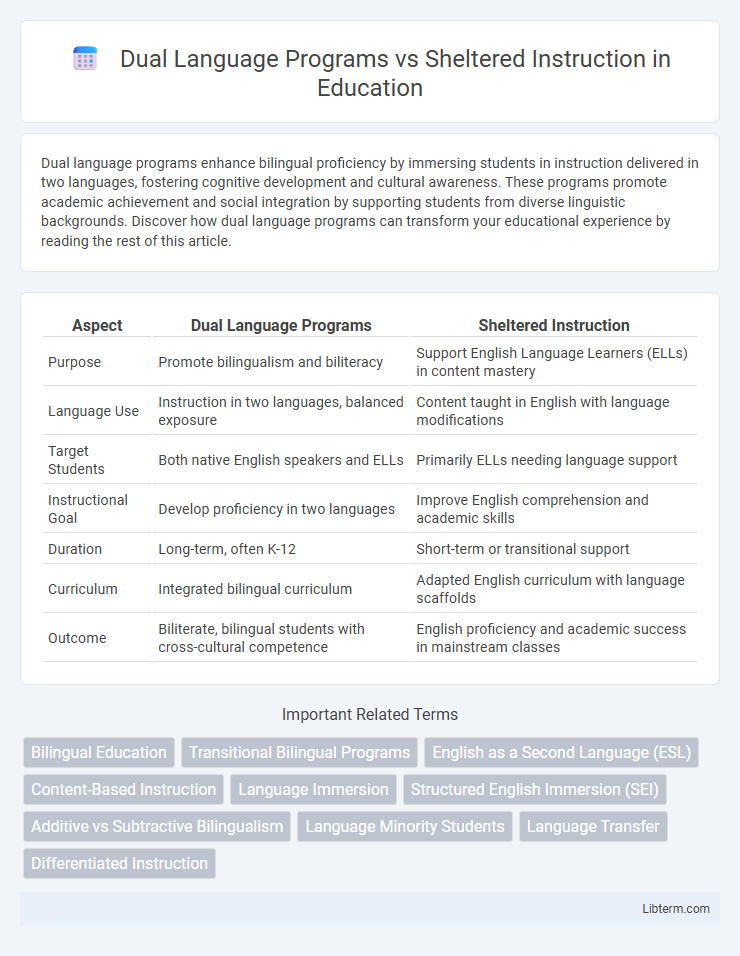Dual language programs enhance bilingual proficiency by immersing students in instruction delivered in two languages, fostering cognitive development and cultural awareness. These programs promote academic achievement and social integration by supporting students from diverse linguistic backgrounds. Discover how dual language programs can transform your educational experience by reading the rest of this article.
Table of Comparison
| Aspect | Dual Language Programs | Sheltered Instruction |
|---|---|---|
| Purpose | Promote bilingualism and biliteracy | Support English Language Learners (ELLs) in content mastery |
| Language Use | Instruction in two languages, balanced exposure | Content taught in English with language modifications |
| Target Students | Both native English speakers and ELLs | Primarily ELLs needing language support |
| Instructional Goal | Develop proficiency in two languages | Improve English comprehension and academic skills |
| Duration | Long-term, often K-12 | Short-term or transitional support |
| Curriculum | Integrated bilingual curriculum | Adapted English curriculum with language scaffolds |
| Outcome | Biliterate, bilingual students with cross-cultural competence | English proficiency and academic success in mainstream classes |
Introduction to Dual Language Programs and Sheltered Instruction
Dual Language Programs immerse students in two languages, promoting bilingualism and biliteracy while enhancing academic achievement and cultural competence. Sheltered Instruction offers tailored teaching strategies that make grade-level content comprehensible for English Language Learners (ELLs) without sacrificing academic rigor. Both approaches aim to support language development, but Dual Language Programs focus on dual-language proficiency whereas Sheltered Instruction emphasizes content accessibility.
Defining Dual Language Programs
Dual Language Programs are bilingual education models designed to promote fluency and literacy in two languages by integrating native English speakers and native speakers of a second language in the same classroom. These programs typically aim for balanced bilingualism, academic achievement, and cross-cultural competence by teaching content in both languages and encouraging active use of both. Unlike Sheltered Instruction, which primarily supports English Language Learners by modifying content for comprehension in English, Dual Language Programs immerse students in dual-language instruction to develop proficiency and literacy in both languages simultaneously.
Understanding Sheltered Instruction
Sheltered Instruction is an educational approach designed to make academic content more accessible for English Language Learners (ELLs) by integrating language development with subject matter teaching. This method uses strategies like visual aids, scaffolding, and modified speech to improve comprehension while promoting language acquisition. Unlike Dual Language Programs, which provide instruction in both English and a student's native language, Sheltered Instruction primarily delivers content in English with supports tailored to learners' proficiency levels.
Goals and Objectives of Each Approach
Dual Language Programs aim to develop bilingualism and biliteracy by promoting proficiency in both the native language and English, fostering academic achievement across subjects. Sheltered Instruction focuses on making grade-level content comprehensible for English Language Learners while simultaneously developing English language skills. The primary goal of Dual Language is balanced bilingualism and cross-cultural competence, whereas Sheltered Instruction emphasizes content mastery alongside language acquisition within English-dominant classrooms.
Instructional Strategies in Dual Language Programs
Dual Language Programs employ instructional strategies such as integrated content and language development, where students learn academic subjects in two languages, fostering bilingualism and biliteracy. These strategies include collaborative learning, scaffolding, and culturally responsive teaching to support language acquisition while maintaining rigorous academic standards. Emphasis on balanced language exposure and interactive activities enhances cognitive skills and cross-cultural competence in both languages.
Key Components of Sheltered Instruction
Sheltered Instruction emphasizes comprehensible input, allowing English Language Learners (ELLs) to access grade-level content through strategies like visual aids, scaffolding, and interactive activities. Key components include clear lesson objectives, explicit teaching of academic vocabulary, and ongoing assessment to monitor student progress. This approach supports language development while promoting academic achievement within mainstream classrooms.
Benefits of Dual Language Programs
Dual Language Programs promote bilingualism and biliteracy by integrating native English speakers and English language learners in instruction, enhancing academic achievement for all students. These programs foster cultural competence and cognitive flexibility, which contribute to improved problem-solving skills and long-term economic opportunities. Research shows that students in Dual Language Programs outperform their peers in Sheltered Instruction in standardized tests and maintain higher language proficiency in both English and the target language.
Advantages of Sheltered Instruction
Sheltered Instruction offers tailored support for English Language Learners (ELLs) by integrating language objectives with academic content, enhancing comprehension and retention. This method provides immediate scaffolding that promotes both language development and subject mastery in real-time classroom settings. Research shows that students in Sheltered Instruction programs often demonstrate higher academic achievement and language proficiency compared to those in traditional dual language programs.
Challenges and Considerations in Implementation
Dual Language Programs face challenges such as ensuring balanced proficiency development in both languages and recruiting qualified bilingual educators, while Sheltered Instruction requires intensive teacher training to effectively modify content for English learners without diluting academic rigor. Implementation considerations include allocating sufficient resources for curriculum development tailored to linguistic and cultural diversity and maintaining consistent family and community engagement to support language acquisition. Sustainability depends on ongoing professional development and assessment strategies that accurately measure language growth alongside academic achievement.
Choosing the Right Approach for Diverse Learners
Dual Language Programs promote bilingualism and biliteracy by integrating native and English-speaking students, enhancing cognitive flexibility and cultural awareness. Sheltered Instruction focuses on making academic content comprehensible for English Language Learners (ELLs) through language-support strategies while accelerating English proficiency. Selecting the right approach depends on student demographics, language goals, and available resources to best support diverse learners' academic and linguistic development.
Dual Language Programs Infographic

 libterm.com
libterm.com